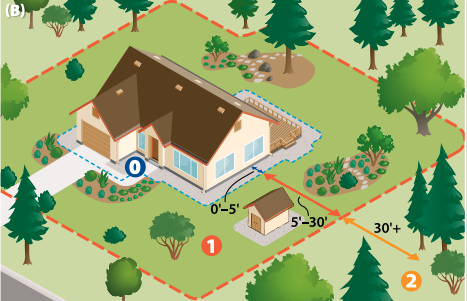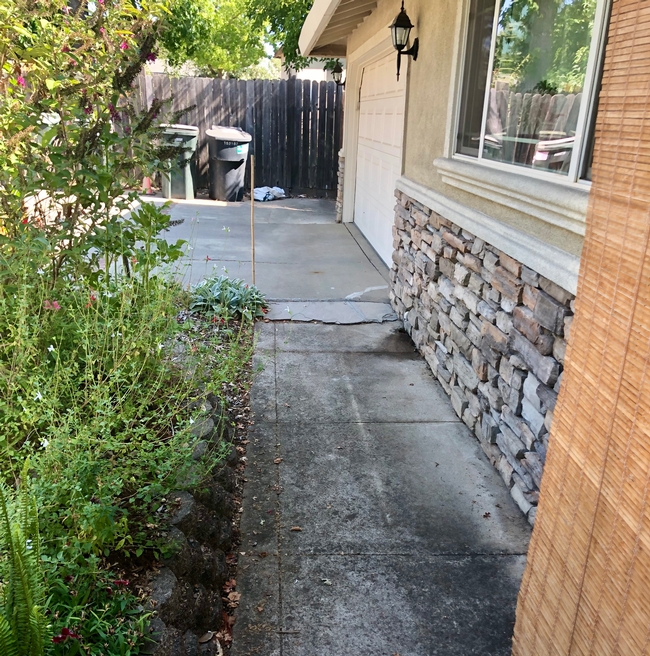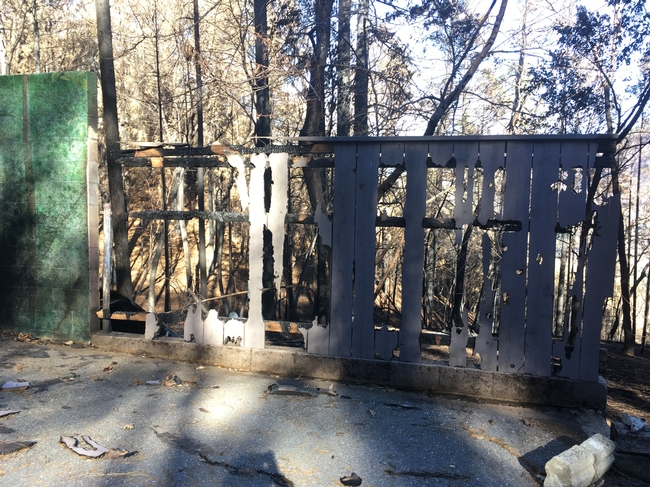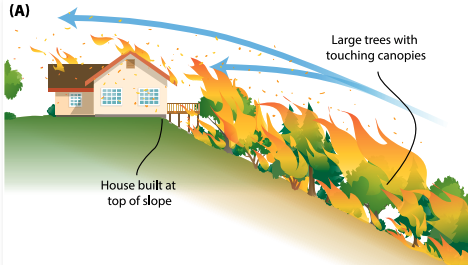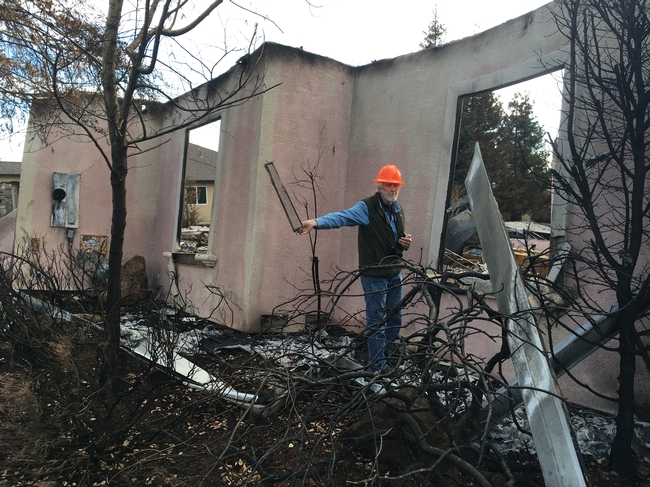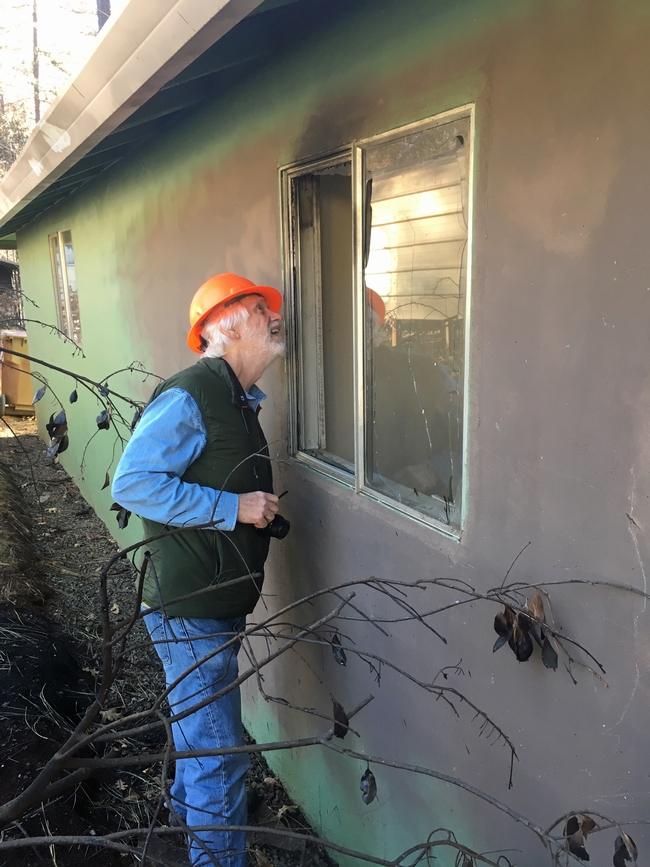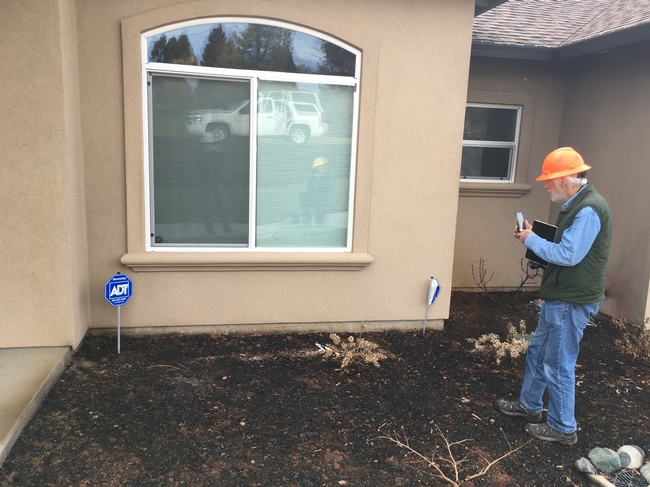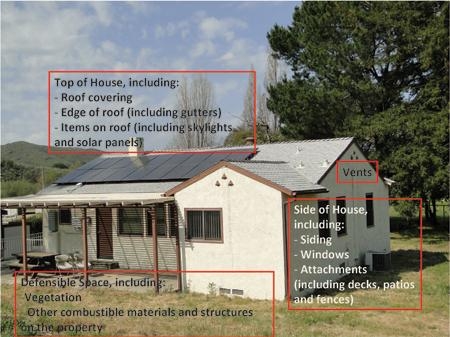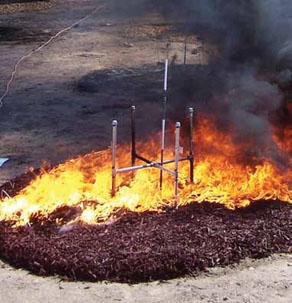Posts Tagged: Steve Quarles
Landscaping with wildfire exposure in mind can protect homes
What can Californians do to improve the chances that their homes will survive a wildfire? Simple actions taken around the home can substantially improve the odds that a home will survive wildfire, according to UC Cooperative Extension advisors.
During wildfire, structures are threatened not only by the flaming front of the fire, but also by flaming embers that are lofted ahead of the fire front and land on fuels such as vegetation or mulch next to the house, igniting new fires. Traditional defensible space tactics are designed to mitigate threats from the flaming front of the fire but do little to address vulnerabilities to embers on or beside a structure.
“Without attention to ember-related risks, defensible space efforts only address a portion of the wildfire threat—especially during wind-driven fires in which embers are the primary source of fire spread,” said co-author Yana Valachovic, UC Cooperative Extension forest advisor in Humboldt and Del Norte counties.
An updated University of California Agriculture and Natural Resources publication describes how embers, radiant heat, and direct flame contact ignite buildings and shares low-cost actions residents can take to create effective defensible space.
“The new publication is up-to-date with the changes in California's defensible space guidance, and it addresses Zone Zero, or the missing ingredient, in defense space,” Valachovic said. “The publication also provides a thoughtful discussion of plant lists and their limitations.”
The odds of a home surviving a wildfire can be substantially improved through careful attention to three things: careful design and maintenance of landscaping; awareness and management of combustible materials on the property such as leaf litter, wood piles and lawn furniture; and incorporation of fire- and ember-resistant construction materials with appropriate installation and maintenance.
“You don't have to spend a lot to protect your home from these wildfire threats,” said Valachovic.
Zone Zero, the area within five feet of the house, is the most vulnerable area around the home, according to the UC Cooperative Extension researchers. “During wind-driven fires, embers are the primary source of fire spread,” Valachovic said.
They recommend removing combustible plants, planter boxes, mulches and wood piles within the five-foot perimeter of the house and beneath attached decks.
“While it may be a radical change, clearing the area next to the house will reduce the risk of ember-caused direct flame contact and radiant heat exposure, which are responsible for many home losses,” she said. “Because embers can accumulate at the base of an exterior wall, it is also important to create a six-inch noncombustible zone between the ground and the start of the building's siding.”
Colorful illustrations in the publication depict the three-zone defensible space strategy and show how spacing out trees on a sloped landscape can prevent fire from climbing from tree to tree to reach a house at the top of the slope.
The 12-page “Reducing the Vulnerability of Building to Wildfire: Vegetation and Landscaping Guidance” is available free for download at https://anrcatalog.ucanr.edu/pdf/8695.pdf.
“Landscaping for fire is part of an overall strategy aimed at reducing risk to the home,” said co-author Steven Swain, UC Cooperative Extension environmental horticulture advisor for Marin and Sonoma counties. “To reduce the risk of home loss, start at the house and work out from there,” he recommended.
Swain, Valachovic and Stephen Quarles, UC Cooperative Extension advisor emeritus, are currently updating a publication on retrofitting houses for wildfire resiliency.
Steps for hardening houses against wildfire can also be found at the Fire in California website: https://ucanr.edu/sites/fire/Prepare/Building.
Wildfire preparedness bill puts UC research to work
Last week, Governor Gavin Newsom signed a series of bills aimed at improving California's wildfire prevention, mitigation and response efforts. AB 38, a bill aimed at reducing wildfire damage to communities, incorporates University of California research to help protect California's existing housing.
“Prior to AB 38, the State's wildfire building policy focus was centered around guiding construction standards for new homes and major remodels,” said Yana Valachovic, UC Cooperative Extension forest advisor for Humboldt and Del Norte counties. “How do we help incentivize homeowners to upgrade and retrofit the 10 million or more existing homes in California to help them become more resilient to wildfire? AB 38 is an attempt to start that important work and to protect Californians.”
After wildfire passes through a community, many are left wondering why one house survives while another nearby burned to the ground. Research by UC Agriculture and Natural Resources scientists shows that building material choices, design and installation options, and maintenance can improve the odds that a house will survive a wildfire.
AB 38, introduced by Assemblymember Jim Wood (D-Santa Rosa) provides mechanisms to develop best practices for community-wide resilience against wildfires through “home hardening,” defensible space and other measures based on UC ANR research. This bill is especially important to Wood because wildfires in 2017 destroyed lives and hundreds of homes in his district and because of his work as a forensic dentist following the Santa Rosa and Paradise wildfires.
“AB 38 was a huge effort by many partners as we sought the best policy solutions to address what is today one of our state's biggest challenges,” said Assemblymember Wood. “I could not have accomplished it without the support and guidance of the people at UC Cooperative Extension Humboldt-Del Norte, especially Dr. Steve Quarles and Yana Valachovic. Their expertise proved invaluable as we worked through this process.”
Studies conducted by Steve Quarles, emeritus UC Cooperative Extension advisor, and his continued work at the Insurance Institute for Business and Home Safety have identified building materials and designs that are more resistant to flying embers from wildfires. Embers are small, fiery pieces of plants, trees or buildings that are light enough to be carried on the wind and can rapidly spread wildfire when they blow ahead of the main fire, starting new fires on or in homes.
Evaluating the homes lost in wildfires that ravaged Paradise, Redding and Santa Rosa have also informed Valachovic and Quarles' recommendations.
Hardening a home to withstand wildland fire exposure does not have to be costly, but it does require an understanding of the exposures the home will experience when threatened by a wildfire.
Their recommended best practices for hardening homes against wildfire can be found in UC ANR Publication 8393 “Home Survival in Wildfire-Prone Areas: Building Materials and Design,” which can be downloaded for free. More information is also at the ANR Fire website https://ucanr.edu/fire.
It only takes a spark
The Las Conchas fire that recently consumed nearly 137,000 acres in Los Alamos, N.M., serves as a reminder of how quickly fire can move if given fuel. I can’t light a barbecue with matches and lighter fluid, but a small ember drifting on the wind can find so many ways to burn down people’s homes if given the right conditions.
Removal of vegetation near Los Alamos National Laboratory, which is part of the UC system, created a buffer and helped spare the lab from the Las Conchas fire, which came within 50 feet. Creating a buffer is one of many preventive measures that can be taken to protect property from wildfires.
In a wildfire-prone area, even if you have a house with a concrete tile roof and noncombustible siding, an ember landing on landscape mulch, igniting plants around the home or floating into a vent on the house or under decks may set the house ablaze, warns a UC Cooperative Extension fire expert.
“From years of observing the aftermath of fires and testing fire-resistant building materials, we have developed a much better understanding about what happens,” says Steve Quarles, UC Cooperative Extension wood performance and durability advisor.
Quarles lists six priority areas for evaluating the vulnerability of homes in fire hazard zones: the roof, vents, landscape plants, windows, decking and siding. For details on how you can reduce the threat of wildfire to your home, visit Quarles' Homeowner's Wildfire Mitigation Guide.
“We know that the zone within about five feet of the home is very important to home survival during a wildfire,” Quarles says.
Landscape mulch provides many benefits to a garden, but Quarles and his colleague Ed Smith, University of Nevada Cooperative Extension natural resource specialist, found that many types of mulch are capable of catching fire and burning. Within five feet of a house, they recommend placing only rock, pavers, brick chips or well-irrigated, low-combustible plants such as lawn or flowers.
Quarles and Smith have published a new manual comparing the relative susceptibility of eight mulch treatments to igniting and burning. To download a free copy of “The Combustibility of Landscape Mulches,” visit the UC Fire Center website.
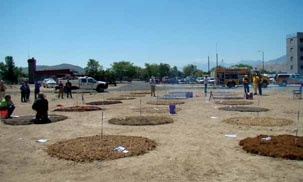
The scientists tested eight types of landscape mulches, shown in this test plot.


